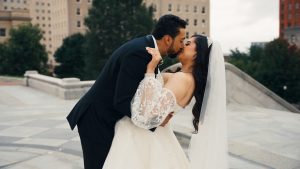Jewish Wedding Traditions
Jewish Wedding Traditions
If you are unfamiliar with Judaism, it varies from Orthodox, Conservative to Reform or modern. Knowing what to expect ahead of time will ensure that you can be present for your friends and family. And who knows, the experience may compel you to learn even more about the faith and culture.
Tisch
The men sit around the table (the “tisch”) that has been laid with food and drink, usually whiskey, and the Groom enjoys some time with the guys before the ceremony. Amongst the singing, chanting, and a bit of fun, the Groom prepares himself for the Bedeken and the commitment he’s about to make to his bride.
Ketubah
There is one ceremonial part to the Tisch when the Rabbi reads through the Ketubah (the Jewish marriage certificate) often to the support and cheers of the male guests. This ensures the Groom is aware of his obligations as a Jewish married man. He may then sign the Ketubah along with the Rabbi and a witness.
At the end of the Tisch, the groom is marched amid a huge amount of excitement and fanfare to see his bride by his father, father-in-law, best man, for the first time for the Badeken ceremony.
Bedeken
The Jewish veiling ceremony, itself, is traced to the story of Jacob, who is tricked by his father-in-law Laban into marrying the wrong bride Leah, the sister of his beloved Rachel. In recognition of Jacob’s experience, the bride is seen (confirmed) and veiled by her groom- just minutes before they walk to the Chuppah to exchange rings. In the veiling of the bride, the groom is reminded that marriage is not only of the physical realm but that of the spiritual realm focusing on the inner beauty and qualities of the woman he is marrying.
Chuppah
The Chuppah, Hebrew for covering, represents the establishment of a Jewish home. The appearance of the bride and groom under a Chuppah before their guests is a public proclamation that they are now bonded together as husband and wife. Symbolized by the cloth canopy and the four poles, a Chuppah is open on all four sides as was the tent of Abraham, welcoming guests from every direction.
Hakafah of the Groom
After the bride joins the groom under Chuppah, she circles him 7 times and then stands by his side symbolizing a spiritual ring of protection. The number seven represents the days of creation, perfection, and completeness in Judaism.
Wine
Wine symbolizes a completed and perfected human life. It starts as a raw ingredient and must go through a fermentation or maturing process to become wine. It’s enjoyed on occasions such as weddings and Shabbat, symbolizing the process of evolution, idealism, and fulfillment.
Sheva Brachot or the Seven Blessings
A key part of a traditional Jewish wedding ceremony. Adapted from ancient rabbinic teachings, the blessing starts with the wine which the couple then drinks, blessings for the rest of their lives, and ends with a communal expression of joy.
Many couples also ask friends or relatives to read some or all of the blessings, or may ask all the guests in attendance to read the blessings from a wedding program. Some couples create their blessings or ask honored guests to create their own.
Breaking of the Glass
The ceremony ends with the familiar sound of the breaking of the glass. As with many Jewish traditions, there’s a plethora of interpretations including the idea of the fragility of relationships to the consummation of the marriage. Perhaps the most widely accepted is as a symbol and reminder of the destruction of the Temple in Jerusalem.
Yichud
In the past, the yichud is the moment when the couple can touch for the first time. Today it serves a more practical role. The ritual is still important because it allows the couple to take their first breaths as a married couple and reflect on their experiences in becoming husband and wife in a private space.
Safta|Grandmother in Hebrew
Horah and Mizinke
The celebratory dance at the reception is called the Horah where guests dance in a circle. The bride and groom are seated on chairs and lifted into the air while holding onto a handkerchief or cloth napkin to signify their union. The Mezinke is a special dance for the parents of the bride or groom when their last child is wed. A lovely observance of honoring parents as mentioned in the Ten Commandments.





